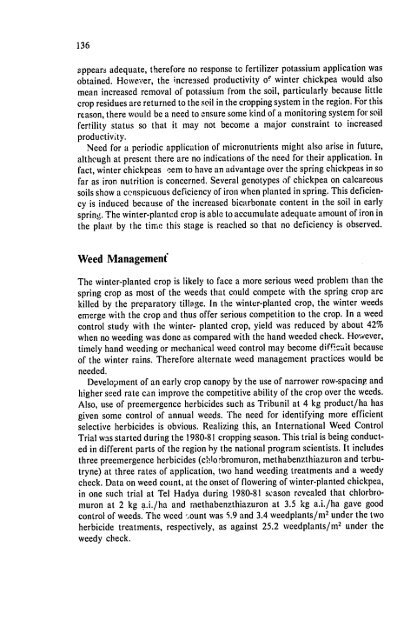I - --ii
I - --ii
I - --ii
Create successful ePaper yourself
Turn your PDF publications into a flip-book with our unique Google optimized e-Paper software.
136<br />
appears adequate, therefore no response to fertilizer potassium application was<br />
obtained. However, the increased productivity of winter chickpea would also<br />
mean increased removal of potassium from the soil, particularly because little<br />
crop residues are returned to the soil in the cropping system in the region. For this<br />
reason, there would be a need to ensure some kind of a monitoring system for soil<br />
fertility status so that it may not become a major constraint to increased<br />
productivity.<br />
Need for a periodic application of micronutrients might also arise in future,<br />
although at present there are no indications of the need for their application. In<br />
fact, winter chickpeas -em to have an advantage over the spring chickpeas in so<br />
far as iron nutrition is concerned. Several genotypes of chickpea on calcareous<br />
soils show a conspicuous deficiency of iron when planted in spring. This deficiency<br />
is induced because of the increased bicarbonate content in the soil in early<br />
spring. The winter-planted crop isable to accumulate adequate amount of iron in<br />
the plant by the time this stage is reached so that no deficiency is observed.<br />
Weed Management<br />
The winter-planted crop is likely to face a more serious weed problem than the<br />
spring crop as most of the weeds that could compete with the spring crop are<br />
killed by the preparatory tillage. In the winter-planted crop, the winter weeds<br />
emerge with the crop and thus offer serious competition to the crop. In a weed<br />
control study with the winter- planted crop, yield was reduced by about 42%<br />
when no weeding was done as compared with the hand weeded check. However,<br />
timely hand weeding or mechanical weed control may become difricuit because<br />
of the winter rains. Therefore alternate weed management practices would be<br />
needed.<br />
Development of an early crop canopy by the use of narrower row-spacing and<br />
higher seed rate can improve the competitive ability of the crop over the weeds.<br />
Also, use of preemergence herbicides such as Tribunil at 4 kg product/ha has<br />
given some control of annual weeds. The need for identifying more efficient<br />
selective herbicides is obvious. Realizing this, an International Weed Control<br />
Trial was started during the 1980-81 cropping season. This trial is being conducted<br />
in different parts of the region by the national program scientists. It includes<br />
three preemergence herbicides (clilorbromuron, methabenzthiazuron and terbutryne)<br />
at three rates of application, two hand weeding treatments and a weedy<br />
check. Data on weed count, at the onset of flowering of winter-planted chickpea,<br />
in one such trial at Tel Hadya during 1980-81 scason revealed that chlorbromuron<br />
at 2 kg a.i./ha and methabenzthiazuron at 3.5 kg a.i./ha gave good<br />
control of weeds. The weed .ount was 5.9 and 3.4 weedplants/m 2 under the two<br />
herbicide treatments, respectively, as against 25.2 weedplants/m 2 under the<br />
weedy check.

















